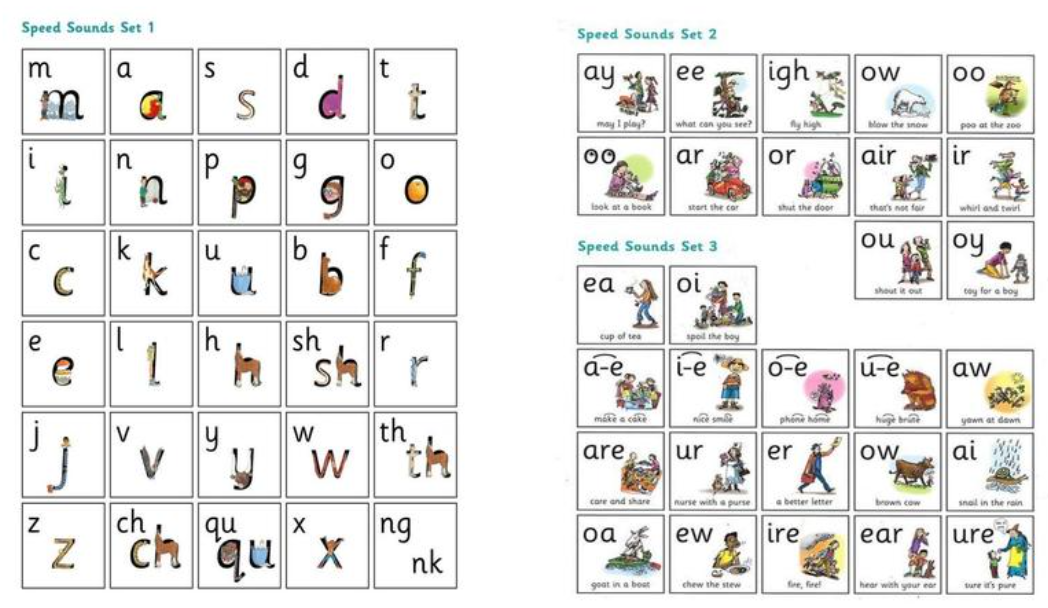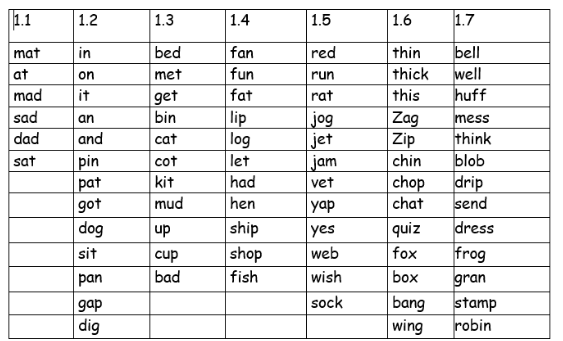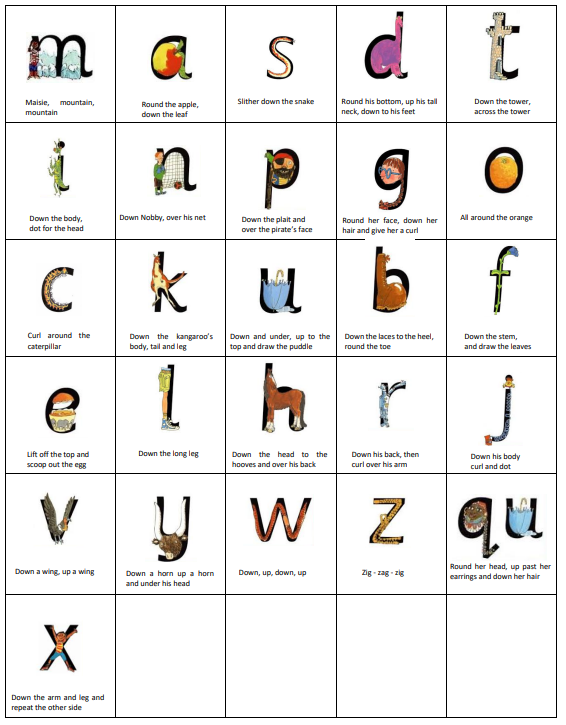Read, Write, Inc. Phonics
What is RWI phonics?
Read Write Inc. (RWI) Phonics is a systematic phonics program designed to help children learn to read and write effectively. It focuses on teaching children the sounds (phonemes) that letters and groups of letters make, along with how to blend these sounds together to read words.
Five key principles underpin the teaching in all Read Write Inc. sessions:
Purpose – know the purpose of every activity and share it with the children, so they know the one thing they should be thinking about
Participation – ensure every child participates throughout the lesson. Partnership work is fundamental to learning
Praise – ensure children are praised for effort and learning, not ability
Pace – teach at an effective pace and devote every moment to teaching and learning
Passion – be passionate about teaching so children can be engaged emotionally.
How will my child be taught to read using phonics?
Read Write Inc. Phonics for Nursery is for children in their last term of Nursery. It supports pre-school children’s literacy progress, including developing their language through story times and teaching phonics. It provides nursery teachers and other staff with the tools they need to ensure every child learns to read confidently, right from the start.
We then continue children's phonics learning when they join us in our Reception class. This is where they learn their Set 1 sounds and how to read the sounds in words. Alongside learning to read their sounds, they practice writing their sounds which not only supports reading but helps children learn to spell accurately.
The elements of RWI phonics
Reading
The children:
- Learn 44 sounds and the corresponding letters/letter groups using simple picture prompts – see below
- Learn to read words using Fred talk and sound blending
- Read from a range of storybooks and non-fictions books matched to their phonic knowledge
- Work well with partners
- Develop comprehension skills in stories by answering 'Find It' and 'Prove It' discussion questions
Writing
The children:
- Learn to write and form the letters/letter groups which represent the 44 sounds with the help of fun phrases
- Learn to write words by using Fred Talk
- Learn to build sentences by practising sentences out loud before they write
Talking
The children
- They work in pairs so that they:
- Answer every question
- Practise every activity with their partner
- Take turns in talking and reading to each other
- Develop ambitious vocabulary
Progressing through the sounds and stages
Children in Early Years are introduced to initial sounds and their first group of words containing those sounds. Children learn how to read the sounds in words and how those sounds can be written down. As children progress, they follow the same format as Early Years but will work on more complex sounds and read books appropriate to their reading level.
Daily sessions of RWI phonics last 30 minutes. Once children become fluent speedy readers they will move on to the RWI Spelling programme and reading comprehension programme in Year 2.
The speed sounds we learn:

Fred Talk
We use pure sounds (‘m’ not’ muh’,’s’ not ‘suh’, etc.) so that your child will be able to blend the sounds into words more easily.
At school we use a puppet called Fred who is an expert on sounding out words! we call it, ‘Fred Talk’. E.g. m-o-p, c-a-t, m-a-n, sh-o-p, b-l-a-ck.
At this stage of learning to read, we do not use the letter names.
Use the link below to support your pronunciation of the sounds correctly.
Red words and Green words
Within all the RWI sessions/books children will be exposed to red and green words to learn to help them to become speedy readers. Red words are words that are not easily decodable and challenge words to extend children’s vocabulary. Green words are linked to the sounds they have been learning and are easily decodable.
Word time words
These are the first sets of words children learn to read. Each set of words correspond to the sounds they have been taught.

Speed 2 Sounds, Phrases and Green Words
The children are then taught Set 2 Sounds - the long vowels.
|
Sound
|
Phrase |
Words to practice reading and spelling |
|
ay |
ay: may I play |
play, day, may, way, say, spray |
|
ee |
ee: what can you see |
see, three, been, green, seen, sleep |
|
igh |
igh: fly high |
high, night, light, fright, bright, might |
|
ow |
ow: blow the snow |
blow, snow, low, show, know, slow |
|
oo |
oo: poo at the zoo |
too, zoo, food, pool, moon, spoon |
|
oo |
oo: look at a book |
took, look, book, shook, cook, foot |
|
ar |
ar: start the car |
car, start, part, star, hard, sharp |
|
or |
or: shut the door |
sort, short, horse, sport, fork, snort |
|
air |
air: that’s not fair |
fair, stair, hair, air, chair, lair |
|
ir |
ir: whirl and twirl |
girl, bird, third, whirl, twirl, dirt |
|
ou |
ou: shout it out |
out, shout, loud, mouth, round, found |
|
oy |
oy: toy for a boy |
toy, boy, enjoy |
Set 3 Speed Sounds, Phrases and Green Words
When they are very confident with all of set 1 and 2 they are taught Set 3 Sounds and their corresponding words.
|
Sounds
|
Phrase |
Words to practice reading and spelling |
|
ea |
Cup of tea |
clean, dream, seat, scream, real |
|
oi |
Spoil the boy |
join, voice, coin |
|
a-e |
Make a cake |
make, cake, name, same, late, date |
|
i-e |
Nice smile |
smile, white, nice, like, time, hide |
|
o-e |
Phone home |
home, hope, spoke, note, broke, phone |
|
u-e |
Huge brute |
tune, rude, huge, brute, use, June |
|
aw |
Yawn at dawn |
saw, las, dawn, crawl, paw, yawn |
|
are |
Care and share |
share, dare, scare, square, bare |
|
ur |
Nurse with a purse |
burn, turn, spurt, nurse, purse, hurt |
|
er |
A better letter |
never, better, weather, after, proper, corner |
|
ow |
Brown cow |
how, down, brown, cow, town, now |
|
ai |
Snail in the rain |
snail, paid, tail, train, paint, rain |
|
oa |
Goat in a boat |
goat, boat, road, throat, toast, coat |
|
ew |
Chew the stew |
chew, new, blew, flew, drew, grew |
|
ire |
Fire! Fire! |
Fire, hire, wire, bon/fire, in/spire, con/spire |
|
ear |
Hear with your ear |
hear, dear, fear, near, year, ear |
|
ure |
Sure it’s pure |
pure, sure, cure, pic/ture, mix/ture, ad/ven/ture |
Reading the story books
During the RWI session children will read the book three times and at each new reading they will have plenty of opportunities to practise using their developing comprehension skills. Children answer questions and think about the characters and events throughout the story.
Writing
Hold a sentence is an activity that encourages children to remember a whole sentence while focusing on spelling and punctuation.
Build a sentence is to give children the opportunity to create their own sentence to that shows the meaning of a word and edit a sentence allows the children to critique a sentence using their knowledge of spelling punctuation and grammar. Children complete a longer piece of independent writing, which gives them the opportunity to show off their creativity and to practice their spelling, grammar and punctuation.
Handwriting phrases

Nonsense words (Alien words)
As well as learning to read and blend real words children will have plenty of opportunities to apply their sound recognition skills on reading ‘Nonsense words’. These words will also feature heavily in the Year One Phonics Screening check in the summer term. These words provide endless opportunities for children to apply and practice their thinking in a range of different contexts.
What is the Year 1 phonics screening check?
If you live in England, your child will be given a phonics screening check in Year 1. The phonics screening check will find out how your child is progressing in phonics.
The test will be carried out informally by your child’s teacher in a one-to-one session. The teacher will ask your child to:
- Sound out and blend graphemes (letters representing sounds) in order to read simple words.
- Read phonically decodable (can be read using phonics) one-syllable and two-syllable words, for example cat, sand, windmill.
- Read a selection of nonsense words (known as pseudo words) to check that your child is not guessing words and is able to read new words.
You can find more information and links to past papers on our phonics screening check page.
To help at home:
Website: Read Write Inc. guide for parents
There are lots of simple things you can do at home to help your child learn phonics.
- Learn how to say the sounds using our Oxford Owl: Phonics or How to pronounce pure sounds.
- Use flashcards to help your child practise saying sounds. Use the flashcards to make words for your child to read through blending. These words could be silly or even made up.
- Listen to your child read every day, even just for five minutes. It really will make a difference. If your child gets stuck on a word, model how to say the sounds and blend them together. If you are worried that the book is at the wrong level for your child, check with your child’s teacher.
- Read aloud to your child every day to show them that reading is fun.
Your child will start to bring books home when they are confident readers, relating to their reading stage. You will find they will bring home a phonics based book, this will aid application, speed and fluency- developing speedy reading! Find time for children to practice reading their books to you at home daily.
Find more tips on our phonics support blog.
The library of films below show parents and carers how we teach children to read and write with Read Write Inc. Phonics.
Video links:
- Understanding Phonics- RWI
- Pronunciation of Phonic Sounds- Pure Sounds
- Teaching a Set 1 Sound
- Blending Independently
- Two Letters, One Sound
- Teacher Blending
You will find further resources from Read Write Inc in the tabs below including mini flashcards and handwriting practice sheets for children to practice at home.
